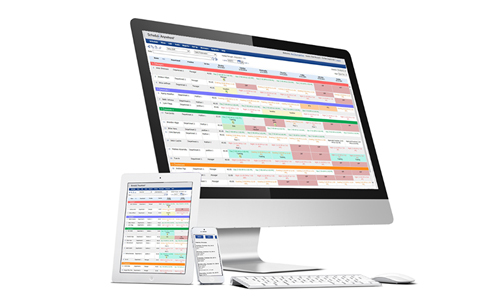It’s no secret that campus safety enforcement is an emotionally and physically demanding profession. For those who work in the field, it is also common knowledge that security officer schedules can add an additional level of stress for managers and supervisors. Ensuring every shift is properly staffed on your hospital, school, college or university campus can be complex and time intensive.
To simplify the scheduling process, many campus police and security departments are implementing online security officer and staff scheduling software. But with so many software options available, how do you know which program will best meet your department’s scheduling specifications?
Here are four things to consider when selecting the scheduling software to fit your campus safety department’s unique requirements.
- Does it do the math? Officer scheduling software should take manually performing staffing calculations off managers and first line supervisors, giving them more time to focus on core responsibilities. This increases productivity and ensures proper staffing levels to appropriately meet organizational requirements. Whether it’s a hospital safety department that schedules based on patient volume, or a college or university that sets staffing levels in accordance with class sessions, administrators should consider whether the software they choose can be customized to make the required calculations based on their safety department’s unique criteria.
- Does it have you covered? When an officer or staff member calls in sick, or if an emergency arises and your department requires extra manpower, supervisors are required to fill open shifts fast. Software that includes an integrated messaging system that allows managers to instantly contact available and qualified individuals or groups of employees ensures shifts are covered with properly-qualified personnel. Look for software that allows managers to message one another about shared officers and provides visibility of schedules across the entire organization to further safeguard against scheduling conflicts and reduce overtime.
- Is it accessible? Providing officers, administrators and staff with anywhere, anytime schedule access ensures every member of the safety department has real-time, accurate schedule information. With an online software system, schedules can be developed, managed and viewed remotely by anyone with permission from any computer or mobile device. Some software also allows employees to submit cover, swap, time-off and other schedule requests online, and the appropriate manager is notified and can see whether the request conflicts with any previously-scheduled shift. For optimal accessibility, safety departments should consider software that includes a mobile app, which some companies include at no additional cost.
- Is it budget friendly? Campus safety departments must maintain high levels of service within hospital, school, university or college budgetary restrictions. When researching scheduling software solutions, administrators should consider the initial investment, as well as monthly and annual costs. Some software companies offer flexible pricing, which can be adjusted to meet the specific personnel requirements of each operation. This ensures the safety department is paying only for the services they need. For added resource management, administrators should look for software that includes reporting tools, which allow them to monitor officer’s shifts and hours — preventing unnecessary overtime costs. Some software even calculates employee utilization and efficiency and can provide an estimate of labor costs for a given work period.
Finding the scheduling program that best meets the staffing demands of your campus safety department will ensure qualified employees are in the appropriate place at the correct time. Additionally, it can cut time spent on scheduling by up to 75% — that’s a sound investment for any public safety organization.
Click here to learn how ScheduleAnywhere works for campus safety departments’ unique scheduling requirements.













